Thrift stores are reshaping how we shop and think about waste. They provide affordable secondhand items, encourage reuse, and reduce landfill waste. Upcycling – turning old items into something new – has gained popularity as a practical way to save resources and lower carbon emissions. Stores like City Thrift even host workshops and fund community programs, creating a positive cycle of reuse and support.
Here’s why thrift stores matter for upcycling:
- Affordable secondhand goods: Clothing at thrift stores often costs under $5, making experimentation accessible.
- Inspiration for reuse: Unique, ever-changing inventory sparks ideas for transforming items.
- Community impact: Proceeds from sales often fund local charities and initiatives.
- Environmental benefits: Upcycling reduces textile waste and conserves resources like water and energy.
How Thrift Stores Support Upcycling
Thrift stores play a pivotal role in making upcycling accessible and inspiring. By offering affordable, one-of-a-kind secondhand items, they encourage shoppers to rethink consumption habits and embrace creativity. Let’s dive into how thrift stores fuel upcycling through affordability, unique finds, and community-focused initiatives.
Affordable Secondhand Finds
One of the biggest ways thrift stores promote upcycling is by making secondhand items incredibly affordable. While a new sweater at a traditional store might cost $50–$100, thrift stores often sell similar items for just a few dollars. In some places, clothing can cost as little as 50 cents, with most items priced under $5. Even higher-quality goods are sold at prices far below retail.
This low-cost model makes experimenting with upcycling easy and low-risk. For just a few dollars, you can try out new ideas or bold transformations without the fear of ruining something expensive. As 17-year-old Olivia McCafferty-Cable puts it:
“Thrifting allowed me to find things at very affordable prices that no one else I knew had.”
This affordability is a key driver behind the explosive growth of the resale market, which is outpacing traditional retail by 21 times. Stores like City Thrift in Kansas City exemplify this approach, offering a range of secondhand items – including clothing, furniture, toys, and household goods – that make creative reuse accessible to families from all walks of life.
Encouraging Creative Thinking
Thrift stores naturally inspire creativity with their ever-changing inventory. Unlike the predictable stock of traditional retailers, thrift stores offer unique and vintage treasures spanning decades of styles and trends. This variety encourages shoppers to reimagine and repurpose items in new ways.
For example, a 1970s blazer with distinctive buttons could inspire a modern twist, a sturdy wooden dresser with outdated hardware might be transformed with a fresh coat of paint, or vintage fabric could become the foundation for a completely new creation. The surprise element of thrift shopping shifts the focus from buying what’s needed to uncovering hidden potential in every find.
This creative mindset is especially popular among younger generations. In 2019, 46% of Gen Z shopped secondhand, compared to 37% of millennials. As 23-year-old Monique Miu Masuko explains:
“[Thrifting] is more affordable, accessible, and eco-friendly – all three of which go hand in hand with sustaining Gen Z’s future.”
Many young shoppers share their upcycling projects on social media, inspiring others to see discarded items in a new light. This growing enthusiasm has transformed secondhand shopping into a vibrant form of self-expression, blending sustainability with creativity.
Supporting Communities Through Non-Profits
Thrift stores often operate as non-profits, tying upcycling efforts to broader community support. By diverting items from landfills and generating funding for local programs, these stores create a ripple effect of positive impact. For instance, every $1 spent at a thrift store can generate up to $3 for local charities.
City Thrift is a prime example. Proceeds from its sales directly fund City Union Mission, which supports homelessness and poverty relief initiatives in Kansas City. When shoppers upcycle items from City Thrift, they’re not just practicing sustainable consumption – they’re also helping to uplift their community.
Beyond funding, thrift stores foster community connections through workshops, events, and partnerships. Many host DIY and upcycling sessions, offer volunteer opportunities, and collaborate with local organizations to expand their reach. These efforts create a shared ecosystem of sustainability, where shopping becomes more than a transaction – it’s a way to build skills, share knowledge, and strengthen community ties.
For example, volunteering at stores like City Thrift allows individuals to learn hands-on skills in repair, restoration, and creative reuse. These skills often extend to personal upcycling projects, creating a ripple effect that spreads practical sustainability practices throughout the community.
How Upcycling Through Thrift Stores Helps the Planet
Upcycling items from thrift stores is a powerful way to conserve resources and reduce waste. Every time you repurpose a garment or piece of furniture, you’re helping to cut down on landfill waste while making better use of existing materials. Let’s dive into how this practice benefits the environment.
Cutting Down Textile Waste in Landfills
The amount of textile waste we generate is staggering. On average, a single person throws away about 82 pounds of textiles each year, contributing to the 92 million tons of textile waste produced globally by the fashion industry annually. Most of this waste ends up in landfills. In 2018, textiles accounted for 11.3 million tons – or 7.7% – of all landfill materials in the United States alone. This is especially disheartening when you consider that many of these items could be upcycled, repurposed, or transformed into something new.
Thrift stores like City Thrift play an important role in addressing this issue. By collecting and reselling donated clothing, furniture, and household goods, they help keep countless textiles out of landfills. For example, when you buy a vintage dress or a pair of worn-out jeans and give them a fresh twist through upcycling, you’re directly cutting down on waste.
As Simple Ecology notes:
“By upcycling carbon footprint-heavy fabrics and other items that have already been manufactured, you’re able to divert the waste from landfill while making the most of the energy already put into them during manufacturing.”
Some thrift stores even collaborate with organizations to recycle unsellable clothing into new products, ensuring that even heavily worn items avoid the landfill.
Saving Resources and Reducing Carbon Output
Upcycling doesn’t just reduce waste – it also conserves vital resources. Producing new clothing is incredibly resource-intensive. For instance, making a single cotton t-shirt requires over 700 gallons of water, while a pair of jeans takes about 2,000 gallons. By choosing upcycled items, you bypass these resource-heavy processes, including cotton farming and synthetic dyeing.
The environmental toll of the fashion industry is immense, accounting for up to 10% of global carbon emissions. Without intervention, emissions from textile manufacturing could increase by 60% by 2030. Shockingly, every second, an entire truckload of clothing is discarded.
Upcycling also reduces the demand for raw materials like organic cotton, synthetic fibers, and dyes. This has ripple effects, conserving water, fuel, and forests while also protecting wildlife habitats. Additionally, manufacturing new clothing generates hazardous waste and contributes to air and water pollution – impacts that are largely avoided when you upcycle.
Buying second-hand items significantly lowers the carbon footprint of your wardrobe because these pieces don’t require the energy-intensive processes of manufacturing, dyeing, or shipping new products. This shift challenges the fast fashion model, which prioritizes cheap, disposable clothing, and helps reduce the environmental strain caused by the industry.
Consumer habits are also evolving. Searches for eco-friendly products have jumped by over 70% in the past five years, and three out of five shoppers now consider environmental impact when making purchases. The secondhand fashion market is projected to grow 11 times faster than traditional retail by 2028, reflecting a growing awareness of the benefits of choosing pre-owned items for upcycling.
When you shop at places like City Thrift and turn donated items into something new, you’re contributing to a circular economy. This system values efficiency and responsibility, moving away from the wasteful “take-make-waste” cycle and instead focusing on extending the life and value of every item produced.
Ideas for Upcycling Thrift Store Items
Turn secondhand finds into one-of-a-kind creations. At places like City Thrift in Kansas City, you’ll discover everything from clothing to furniture, perfect for sparking your next upcycling project. Below are some practical ideas for transforming clothing and furniture into something fresh and personal.
Clothing and Accessories
Upcycling clothing is a great way to experiment with creativity, especially if you’re new to it. Start with forgiving fabrics like t-shirts, dresses, skirts, or jeans. These materials are easy to work with, even for beginners. If sewing isn’t your thing, fabric glue can be a lifesaver for adding embellishments, mending tears, or attaching decorative elements.
Even small changes can make a big impact. For instance, a maxi dress that’s too large can be turned into a chic skirt by adding a simple waistband. A men’s shirt can be tailored into a fitted blouse with a few basic adjustments. Got old t-shirts lying around? They can be repurposed into head wraps or cut into yarn for knitting. You can also add functional touches, like sewing on pockets or altering hemlines, sleeves, or collars to make the garment truly your own. Feeling creative? Try turning a dress shirt into an infinity scarf with just a bit of sewing – it’s a stylish and versatile accessory.
Furniture and Home Items
If fabric projects aren’t your thing, furniture offers a whole new world of possibilities for upcycling. With a little effort, you can transform outdated pieces into stunning centerpieces for your home. Whitney Frances Falk, founder and CEO of ZZ Driggs, shares this tip:
“Paint is your best friend when it comes to entry-level upcycling…You’ll create an evocative statement piece that’s not only useful, but a conversation starter”.
Start by looking for solid wood furniture – these pieces are perfect for refinishing, painting, or staining to suit your style. Even simple updates, like swapping out old knobs and handles for modern hardware, can breathe new life into furniture. You can also repurpose items creatively. For example, take the doors off an old cabinet, sand it down, and paint it to create a custom bar for displaying glassware. Or, add wheels to a small table to transform it into a mobile bar cart.
For those ready to take on bigger challenges, think about reimagining items entirely. An old door could become a unique coffee table top when paired with wooden legs. A dresser might find new life as a bathroom sink vanity with some careful modifications. Even a wooden headboard could be turned into a charming entryway bench. Another idea? Add a butcher block to a table, and you’ve got yourself a functional kitchen island.
Grace Baena, interiors curator for Kaiyo, sums it up perfectly:
“Repurposing furniture is also commonly known as upcycling. For most, it’s a way to take something that may have seen better days and make it feel fully custom and unique”.
These projects don’t just add personality to your space – they also promote sustainability. The key to successful upcycling is starting with pieces that are practical for your home. With just a few basic tools – like paintbrushes, fabric scissors, a hot glue gun, and a tape measure – you can dive into beginner-friendly projects and create items that are both environmentally friendly and uniquely yours.
Building Community Through Thrift Stores
Thrift stores do more than sell secondhand items – they bring people together around the idea of reuse and sustainability. By creating spaces for donations, volunteering, and creative activities, these stores become hubs where local neighborhoods grow stronger. This collaborative spirit not only encourages reuse but also makes upcycling a shared effort.
Donation and Volunteer Programs
It all starts with donations. When you drop off clothing, furniture, or household items, you’re contributing to a cycle of reuse that benefits the entire community. For example, City Thrift in Kansas City uses donations to fuel its mission of sustainability.
Volunteering takes this connection a step further. At places like City Thrift, volunteers sort donations, assist shoppers, and help with store operations. This experience not only supports a meaningful cause but also helps people build new skills and relationships. Beyond these efforts, thrift stores often take things up a notch with creative community events.
DIY Workshops and Community Events
Many thrift stores host workshops and events that focus on upcycling and creative reuse. These DIY sessions teach people how to turn secondhand items into one-of-a-kind treasures, making the process fun and accessible for all ages.
Events like these do more than teach skills – they bring people together. Whether it’s a hands-on class or a casual gathering, these activities inspire creativity, share ideas, and strengthen a shared commitment to sustainability.
Through donation drives, volunteer opportunities, and creative events, thrift stores show how reuse and upcycling can build stronger, more connected communities. They’re not just about giving items a second life – they’re about bringing people together to make a difference.
The Long-Term Impact of Thrift Store Upcycling
Thrift stores are transforming how communities approach consumption and waste, promoting a shift from a disposable mindset to one centered on creativity and reuse. By offering affordable options for upcycling, these stores make it easier for neighborhoods to embrace sustainable habits.
The environmental impact of this shift is undeniable. For instance, Goodwill Industries diverts over 4 billion pounds of usable goods from landfills each year, showcasing how thrift stores contribute to reducing waste while also delivering economic benefits.
“Thrift shopping is a key part of the circular economy. It keeps items in use for as long as possible, reducing waste and conserving resources.” – City Thrift
Upcycled thrift store finds often inspire creativity. A $10 chandelier transformed into a one-of-a-kind light fixture or French doors repurposed into a greenhouse are just a couple of examples of how people are rethinking waste. These projects not only reduce waste but also build confidence in repair and reuse, nudging consumers toward more sustainable purchasing decisions over time.
Beyond environmental benefits, the social impact is equally significant. City Thrift, for example, uses proceeds from donated items to support homelessness and poverty relief efforts, tying upcycling directly to meaningful community change. This gradual cultural shift gains momentum as more people donate, attend DIY workshops, and share their upcycling successes. Together, these actions reduce the demand for new goods and foster stronger community ties around shared environmental goals.
The ripple effects extend even further. As upcycling gains mainstream appeal, it challenges industries like fast fashion by encouraging manufacturers to design products that last longer and are easier to repair. This growing consumer demand for sustainable options creates a feedback loop, pushing companies to adopt more responsible production practices.
Thrift stores like City Thrift show how upcycling can thrive when communities are provided with accessible resources and a shared sense of purpose. By engaging residents through education and visible success stories, these efforts are reshaping consumption habits and even influencing how products are made. The result? Communities that waste less, create more, and work together toward a more sustainable future.
FAQs
How do thrift stores support sustainability and upcycling?
Thrift stores are an important part of reducing waste and conserving resources. By giving second-hand items – like clothing, furniture, and household goods – a second chance, they help keep these items out of landfills. This not only cuts down on waste but also saves natural resources and reduces carbon emissions tied to producing new goods.
Beyond their environmental benefits, thrift stores make it easy to get creative. They offer affordable, pre-owned items that can be repurposed or transformed into something entirely new. This encourages a mindset of reimagining what we already have, fostering a sense of responsibility toward the planet. Whether you’re donating or shopping, thrift stores provide a simple yet meaningful way to contribute to a healthier environment.
How do thrift stores support their communities and promote sustainability?
Thrift stores are an important part of many communities, offering more than just affordable second-hand items. They help create local jobs and generate funds for charitable programs aimed at tackling challenges like homelessness and poverty. Plus, they contribute to reducing waste by giving pre-owned goods a second chance, helping to conserve resources and lessen environmental impact.
These stores also bring people together. By accepting donations, offering volunteer opportunities, and sparking interest in upcycling projects, thrift stores strengthen community bonds. They promote a mindset of reuse and eco-friendly living, making them a hub for positive change.
What are some easy upcycling ideas using thrift store finds?
Thrift stores are packed with hidden gems, making them perfect for simple and creative upcycling projects. For instance, you can breathe new life into old furniture with a fresh coat of paint or by swapping out the hardware. Got oversized shirts? Turn them into stylish tank tops. Or, give worn-out denim a second chance by crafting cozy quilts or sturdy tote bags.
Other fun ideas include transforming glass jars into decorative light fixtures or handy storage containers. You could also modernize picture frames or use old fabrics to create one-of-a-kind wall art. Upcycling isn’t just easy on your wallet – it’s a fantastic way to embrace sustainability while adding a personal flair to your home or wardrobe!

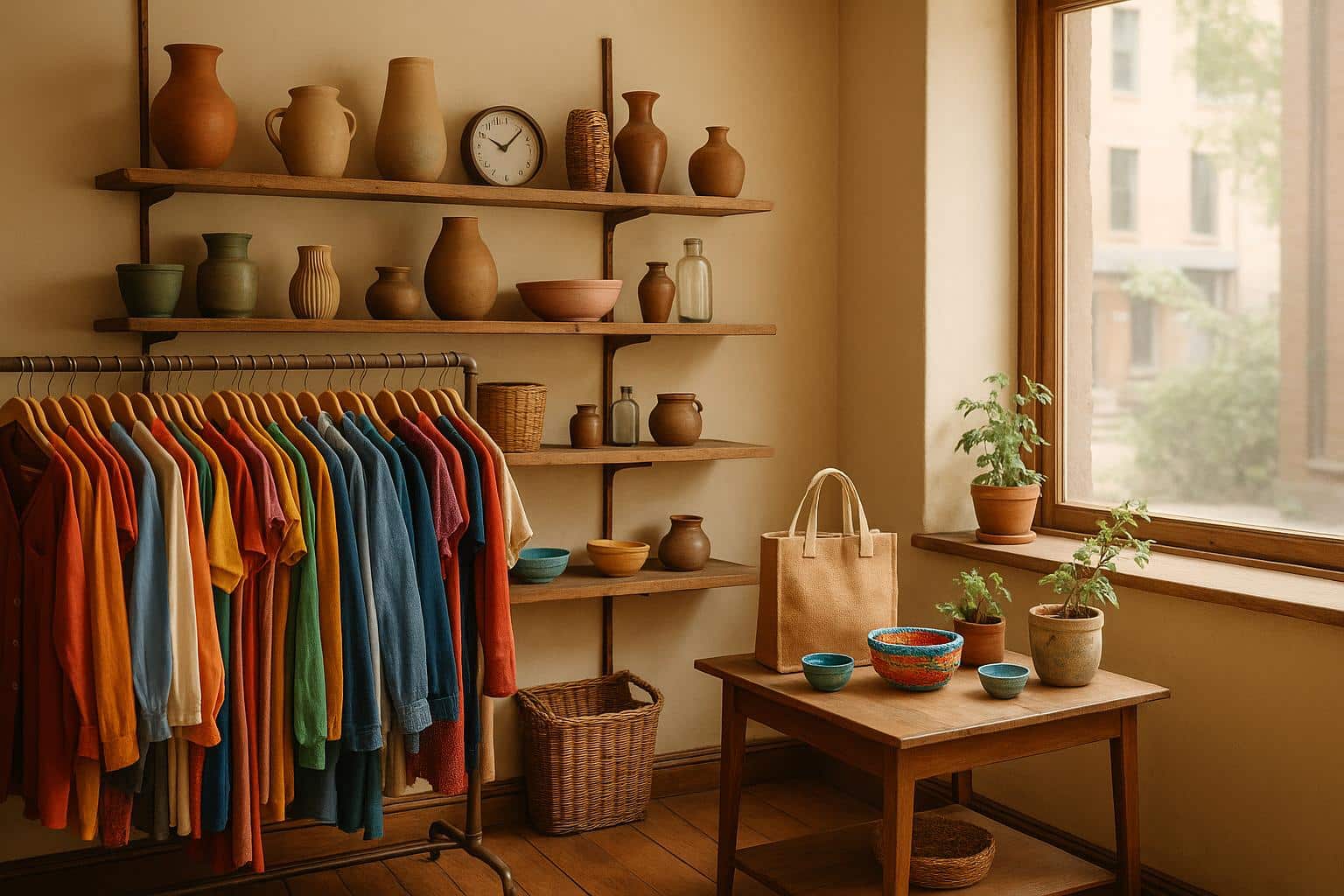
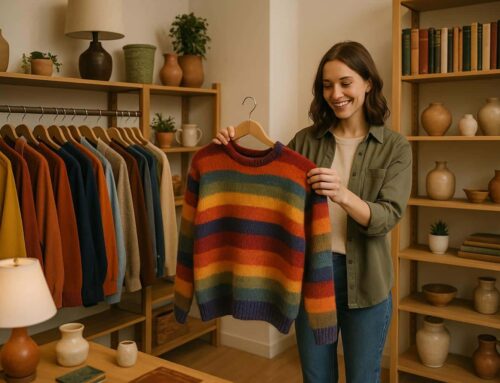
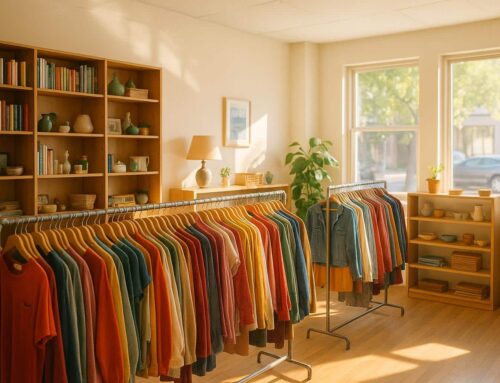
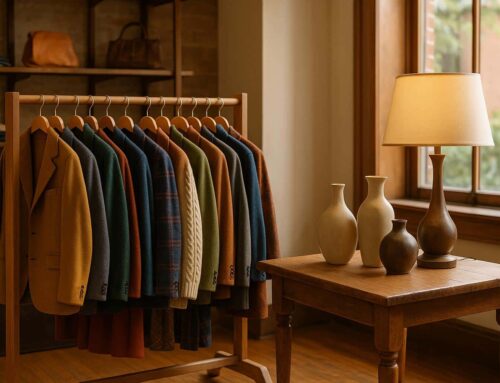

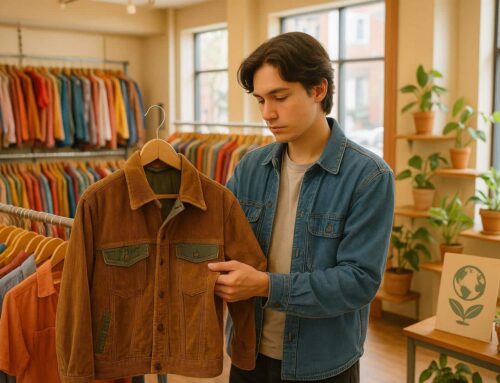
Leave A Comment